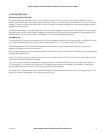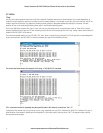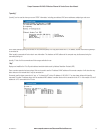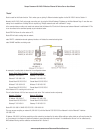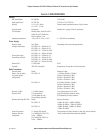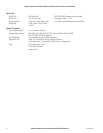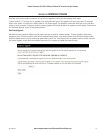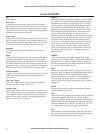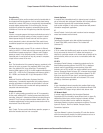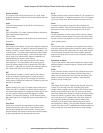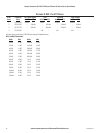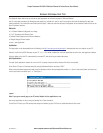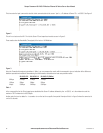www.cooperbussmann.com/BussmannWirelessResources
81
Cooper Bussmann BU-245U-E Wireless Ethernet & Device Server User Manual
3A1576Rev1.6
Encryption Key
An alphanumeric (letters and/or numbers) series that enables data to
be encrypted and then decrypted so it can be safely shared among
members of a network. WEP uses an encryption key that automatically
encrypts outgoing wireless data. On the receiving side, the same
encryption key enables the computer to automatically decrypt the
information so it can be read. Encryption keys should be kept secret
Firewall
A device or computer program that keeps unauthorized users out of a
private network. Everything entering or leaving a system's internal
network passes through the firewall and must meet the system's
security standards in order to be transmitted. Often used to keep
unauthorized people from using systems connected to the Internet.
Hub
A multiport device used to connect PCs to a network via Ethernet
cabling or via 802.11. Wired hubs can have numerous ports and can
transmit data at speeds ranging from 10 Mbps to multi-Gigabyte
speeds per second. A hub transmits packets it receives to all the
connected ports. A small wired hub may only connect 4 computers;
a large hub can connect 48 or more.
Hz
Hertz. The international unit for measuring frequency, equivalent to the
older unit of cycles per second. One megahertz (MHz) is one million
hertz. One gigahertz (GHz) is one billion hertz. The standard US
electrical power frequency is 60 Hz, the AM broadcast radio fequency
band is 535—1605 kHz, the FM broadcast radio frequency band is
88—108MHz, and wireless 802.11b/g LANs operate at 2.4GHz.
IEEE
Institute of Electrical and Electronics Engineers, New York,
www.ieee.org. A membership organization that includes engineers,
scientists and students in electronics and allied fields. It has more
than 300,000 members and is involved with setting standards for
computers and communications.
Infrastructure Mode
An 802.11 setting providing connectivity to an AP. As compared to
Ad-Hoc mode, whereby 802.11 devices communicate directly with
each other, clients set in Infrastructure Mode all pass data through a
central AP. The AP not only mediates wireless network traffic in the
immediate neighborhood, but also provides communication with the
wired network. See Ad-Hoc and AP.
I/O
Input / Output. The term used to describe any operation, program or
device that transfers data to or from a computer.
Internet Appliance
A computer that is intended primarily for Internet access is simple to
set up and usually does not support installation of third-party software.
These computers generally offer customized web browsing,
touch-screen navigation, e-mail services, entertainment and personal
information management applications.
IP
Internet Protocol. A set of rules used to send and receive messages
across local networks and the Internet.
IP telephony
Technology that supports voice, data and video transmission via
IP-based LANs, WANs, and the Internet. This includes VoIP
(Voice over IP).
IP Address
A 32-bit number that identifies each sender or receiver of information
that is sent across the Internet. An IP address has two parts: an
identifier of a particular network on the Internet and an identifier of the
particular device (which can be a server or a workstation) within that
network.
IPX-SPX
Internetwork Packet Exchange, a networking protocol used by the
Novell NetWare operating systems. Like UDP/IP, IPX is a datagram
protocol used for connectionless communications. Higher-level
protocols, such as SPX and NCP, are used for additional error recovery
services. Sequenced Packet Exchange, SPX, a transport layer protocol
(layer 4 of the OSI Model) used in Novell Netware networks. The SPX
layer sits on top of the IPX layer (layer 3) and provides connection-
oriented services between two nodes on the network. SPX is used
primarily by client/server applications.
ISDN
A type of broadband Internet connection that provides digital service
from the customer's premises to the dial-up telephone network. ISDN
uses standard POTS copper wiring to deliver voice, data or video.
ISO Network Model
A network model developed by the International Standards
Organization (ISO) that consists of seven different levels, or layers. By
standardizing these layers, and the interfaces in between, different
portions of a given protocol can be modified or changed as
technologies advance or systems requirements are altered. The seven
layers are: Physical , Data Link, Network, Transport, Session,
Presentation, Application.
LAN
Local Area Network. A system of connecting PCs and other devices
within the same physical proximity for sharing resources such as an
Internet connections, printers, files and drives.



